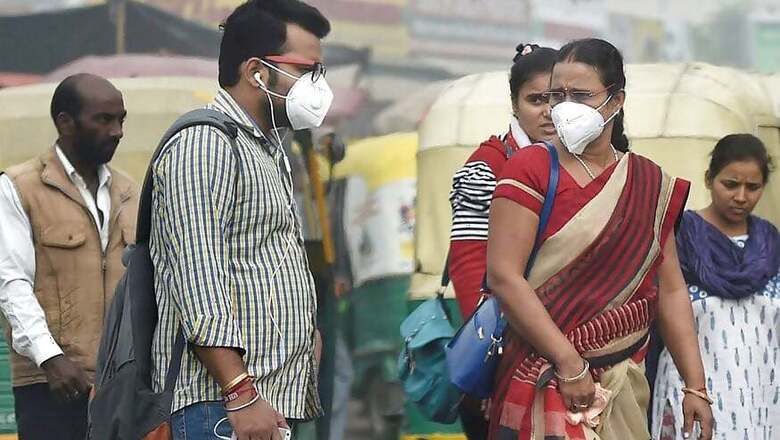
views
New Delhi: The emergency plan to combat air pollution came into force on Monday in the Delhi-NCR region where air quality remained poor, even as the Centre claimed that bad air quality days in the city have come down considerably this year.
The Graded Response Action Plan (GRAP), which has come into effect for the second year, ensures stringent actions are taken based on the air quality.
Under the plan, measures such as mechanised sweeping of roads, ban on garbage burning, pollution control measures at brick kilns and deployment of police to ensure smooth passage of traffic at vulnerable areas are in force in Delhi-National Capital Region (NCR) as the air quality lies in the poor category.
Environment minister Harsh Vardhan, who launched an air quality early warning system for Delhi, said the Badarpur Thermal Power Plant will be closed from October 15. He also said the number of mechanised road sweeping machines in the national capital will increase from 52 to 64 by November-end.
With farmers already burning stubble, the environment ministry said the government has released Rs 591.65 crore to Punjab, Haryana, Uttar Pradesh and NCT of Delhi for promotion of agricultural mechanisation to manage crop residue. It said the number of active fire detections was less in 2018 when compared to 2017 and 2016.
The air quality in Delhi remained poor with a drop in wind speed, even as authorities predicted further fall in the air quality index of the national capital in the coming days.
The overall air quality index (AQI) recorded at 4pm on Monday was 218, which falls in the poor category, according to Centre-run System of Air Quality and Weather Forecasting and Research (SAFAR). On Saturday, the AQI of the national capital stood at 201. According to the CPCB website, Anand Vihar recorded an AQI of 318, DTU registered 288, ITO recorded 253 and Jahangirpuri recorded an AQI of 311.
An AQI between 0-50 is considered 'good', 51-100 'satisfactory', 101-200 'moderate', 201-300 'poor', 301-400 'very poor', and 401-500 'severe'. Delhi's neighbouring regions of Faridabad and Gurgaon both recorded poor air quality.
If the air quality deteriorates further to very poor category then additional measures under GRAP such as enhancing parking fees 3-4 times and increasing frequency of metro and buses would be implemented, an official with the Central Pollution Control Board (CPCB) said.
It said if the air quality falls in the severe category, measures like increasing frequency of sprinkling of water on roads and identifying road stretches with high dust generation would be implemented.
If the air quality falls to severe plus emergency category, then measures like stopping entry of trucks into Delhi (except essential commodities), stopping construction activities and appointment of task force to take decision on any additional steps, including shutting of schools, are implemented.
Union minister Vardhan said the use of water sprinklers and the opening of the Western Peripheral Expressway will bring about a further reduction in pollution. He said along with the initiatives taken by the government, the participation of the society is an imperative.
"With an outlay of Rs 1,151.80 crore under the new Central Sector Scheme, the Centre has already released Rs 591.65 crore to Punjab, Haryana, Uttar Pradesh and NCT of Delhi for the promotion of agricultural mechanization for in-situ management of crop residue," an official statement quoting Vardhan said.
The minister said 41 teams of the CPCB have been deployed in Delhi and NCR cities of Ghaziabad, NOIDA, Gurgaon and Faridabad to monitor and supervise dust mitigation and other air pollution abatement measures to ensure effective compliance, while terming them as "eyes and ears" of his ministry. He also said the use of water sprinklers and the opening of the expressway will bring about a further reduction in pollution.
Union environment secretary CK Mishra said the number of "Good, Satisfactory and Moderate" days was 157 in 2018 (Up to October 13) compared to 150 in 2017 and 107 in 2016 during the corresponding period. He added that similarly, the number of "Poor, Very Poor and Severe days" have come down from 167 in 2016 to 136 in 2017 to 129 in 2018 during the corresponding period.
Comparing the PM10 and PM2.5 levels, Mishra underlined that both PM 10 and PM 2.5 have shown a significant reduction in the winter months (September-October) this year compared to last year. "There is a reduction of 46 per cent in PM10 levels in September 2018 compared to last year and a 15 per cent reduction in October.
"There is a reduction of 28 per cent in the PM2.5 levels in September 2018 compared to last year and a reduction of 22 per cent in October," Mishra said. He said the number of active fire detections in 2018 is less in comparison to 207 and 2016 till October 14, 2018 (From Sep 1, 2018). "The numbers are 75 per cent lower than last year in Punjab and 40 per cent lower in case of Haryana," he said.




















Comments
0 comment